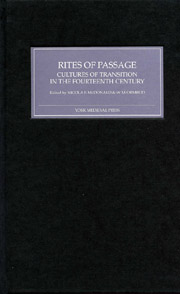Book contents
- Frontmatter
- Contents
- List of Contributors
- Preface
- Introduction: Rites of Passage
- Re-writing a Rite of Passage: The Peculiar Funeral of Edward II
- Coming to Kingship: Boy Kings and the Passage to Power in Fourteenth-Century England
- Boy/Man into Clerk/Priest: The Making of the Late Medieval Clergy
- Manners Maketh Man: Living, Dining and Becoming a Man in the Later Middle Ages
- Rites of Passage in French and English Romances
- Becoming Woman in Chaucer: ‘On ne naît pas femme, on le meurt’
- John Gower's Fear of Flying: Transitional Masculinities in the Confessio Amantis
- ‘Le moment de conclure’: Initiation as Retrospection in Froissart's Dits amoureux
- Index
- YORK MEDIEVAL PRESS: PUBLICATIONS
Re-writing a Rite of Passage: The Peculiar Funeral of Edward II
Published online by Cambridge University Press: 12 September 2012
- Frontmatter
- Contents
- List of Contributors
- Preface
- Introduction: Rites of Passage
- Re-writing a Rite of Passage: The Peculiar Funeral of Edward II
- Coming to Kingship: Boy Kings and the Passage to Power in Fourteenth-Century England
- Boy/Man into Clerk/Priest: The Making of the Late Medieval Clergy
- Manners Maketh Man: Living, Dining and Becoming a Man in the Later Middle Ages
- Rites of Passage in French and English Romances
- Becoming Woman in Chaucer: ‘On ne naît pas femme, on le meurt’
- John Gower's Fear of Flying: Transitional Masculinities in the Confessio Amantis
- ‘Le moment de conclure’: Initiation as Retrospection in Froissart's Dits amoureux
- Index
- YORK MEDIEVAL PRESS: PUBLICATIONS
Summary
Since Arnold Van Gennep first discussed his ideas on ‘rites of passage’ at the beginning of the twentieth century, it has come to be recognized that ritual, when deployed in particular types of social or political context, functions as a mechanism for mediating changes of status or the transferral of authority. In essence, ritual plays a double trick, acting not only on the individual or individuals at the centre of the ritual, but also manipulating the perspective of those situated on the periphery of the ritual who observe a ‘seeming transformation’ taking place. In the medieval period, the transforming aspect of ritual lent it a particular importance within the greatest of the royal rites of passage, that which was associated with the accession of a king. At the centre of this royal rite of passage were the rituals of coronation, with the act of consecration located at the very heart of the process. However, by the fourteenth century, the burgeoning ritual associated with the burial of a king had also come to acquire symbolic significance for the process of legitimating the royal authority of the dead king's successor.
To understand how a royal funeral might have worked as a mechanism for legitimating royal authority, it is helpful to turn to the work of a second social theorist of the early twentieth century, Max Weber. Weber outlined three criteria he saw as essential to the effective operation of a legitimation process.
- Type
- Chapter
- Information
- Rites of PassageCultures of Transition in the Fourteenth Century, pp. 13 - 30Publisher: Boydell & BrewerPrint publication year: 2004



